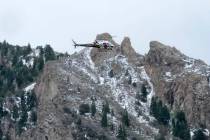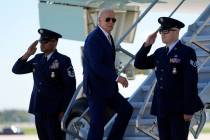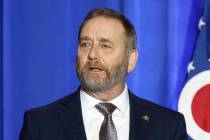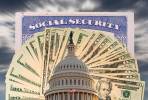Retiree health benefits threaten other programs, report says
CARSON CITY -- If Nevada's elected officials don't act quickly to rein in the cost of providing subsidized health care to their retirees, then programs and services from education to public safety will suffer as more money is diverted to a benefit that has disappeared from the private sector, a new Las Vegas Chamber of Commerce study suggests.
Since the state is not investing any significant amounts of money to cover the future cost of the benefit, estimated at $4 billion over the next 30 years, the bill accumulating now will come due well into the future, affecting Nevada residents who aren't even born yet, said Steve Hill, the incoming chamber chairman.
"Committing to expenditures that the next generation will be forced to make is just wrong," he said. "That's how you get into trouble down the road."
The study, "An Overview and Comparative Analysis of Nevada's State Retiree Health Insurance Subsidy," will be given to lawmakers and other officials as evidence that immediate action is needed on the critical issue.
The numbers are impressive.
If the state continues to pay for the benefit on a yearly ongoing basis, and the current benefit and subsidy structure remains in place, the projected cost in 2038 would be $600 million per year for retiree benefits alone, the study says.
In 2018, only 10 years from today, the projected yearly cost is nearly $150 million per year compared to the current cost of under $50 million.
The state currently provides an average annual base subsidy of $4,925 to retired workers and their families and has promised the same to the 26,346 active workers.
Eighty percent of the $4 billion unfunded liability is for the active workers.
Virtually all private sector Nevada workers must rely on Medicare, beginning at age 65, for their health insurance needs in retirement.
Hill expects the Legislature will seek to implement reforms to the program in 2009, but said the study suggests modest tweaking won't get the job done.
Major changes, including the possibility that the benefit be eliminated outright for new state hires or curtailed for existing employees, will be required to bring the spiraling costs under control, he said.
Ben Kieckhefer, a spokesman for Gov. Jim Gibbons, said the retiree health insurance unfunded liability is a concern that the governor addressed in 2007 with a $50 million appropriation. Some of that was reduced due to the state's budget problems, but Gibbons will continue to try to find ways to pay down the liability in future budgets, he said.
As to the elimination or reduction of the benefit, it is an issue that is being examined but no firm conclusions have been reached, Kieckhefer said. A panel appointed by Gibbons to look for government efficiencies is evaluating the state employee health insurance program and is expected to make some recommendations, he said.
"It is undeniable the program is a burden to the state and takes away resources from other areas of critical need," Kieckhefer said. "We're looking at it but we don't have the answer yet. We hope to have one by the time the Legislature rolls around."
Sen. Bob Beers, R-Las Vegas, said he believes the benefit could be eliminated for state employees hired after 1987 because that is when new hires began participating in Medicare.
"I believe we have an absolute moral obligation to provide for retirement health care for people who started employment prior to 1987," he said.
But Beers said providing for retirement does not have to mean that the state must continue to subsidize the health care costs of employees who retire at an early age. In Nevada, state employees can retire at any age after 30 years of service.
State health benefit coverage could begin at age 65, just like for Medicare, he said. For those who choose to retire earlier, a program could be crafted to let them continue to participate in the state health plan but bear the costs of their own medical insurance, Beers said.
Not all lawmakers view the retiree health insurance subsidy as a pressing issue.
Assemblyman Marcus Conklin, D-Las Vegas, the assistant majority floor leader, said the state's current budget crisis will be a much higher priority in the upcoming session.
"All states have been 'pay as you go' forever," he said. "It makes practical sense."
The benefit may need some adjustments, but it was established for a reason, which was to help recruit and retain qualified workers, Conklin said. Eliminating the subsidy could just lead to a shift to retirees accessing other government programs, resulting in no net savings, he said.
"Just because private companies no longer provide benefits, is that right?" Conklin asked. "Allowing government retirees the opportunity to buy health insurance, which is still expensive for them, provides a safety net."
Unlike the state public pension program, there is no legal right to the health insurance subsidy, now being provided to about 6,500 retirees, said Jeremy Aguero, a principal analyst with the firm Applied Analysis, which performed the study along with the firm Hobbs, Ong & Associates.
That means lawmakers could do away with the benefit entirely immediately for all retirees and current employees, or take some less sweeping but still significant change, such as doing away with the subsidy for newly hired state workers.
Gov. Kenny Guinn proposed that alternative in the 2005 session of the Legislature, but it was ultimately rejected by lawmakers.
Hill said policy makers may believe they have a moral obligation to provide the coverage to at least some groups, such a current retirees or those nearing retirement age. But when the more than 26,000 state employees begin to retire in larger numbers, the costs of the subsidy will begin to climb dramatically, he said.
Other options to reducing the cost of the benefit include establishing a lifetime total contribution for retirees, requiring employee contributions or reducing the duration of the subsidy through a fixed cap on time or by imposing age restrictions to reduce the average time between commencement of the subsidy and Medicare eligibility, the chamber study says.
The Legislature could also freeze the subsidy at the current level, cut it by 50 percent or eliminate the subsidy for family members of retirees as a way to reduce costs.
The state health insurance program for current employees and retirees, overseen by the Public Employees' Benefits Program Board, has proposed some changes for the upcoming budget with an eye to curtailing costs.
They include shifting a greater portion of the cost to participants and prospectively eliminating state subsidies for those retiring after June 30, 2010 with less than 15 years' service.
Those measures "would help curtail the growth in annual cash cost and the rate at which the unfunded liability grows in the future," the chamber study says. "However, taken alone, they would not address the overriding lack of an actuarially sound funding system for the program."
If the subsidy is continued in some form, there is also the policy issue of how to pay for it.
The cost can be covered in a "pay as you go" style, as is being done for the most part now in Nevada, or by investing money now to pay for the cost of the benefit in future years.
Aguero said few states are pursing the pre-funding option.
"What is going on today in Nevada is the rule, not the exception, he said.
In a 2007 survey of state health benefit programs, only 6 of 41 reporting states fully funded their required annual contributions, the report says.
"That said, funding only 15 percent of (the) annual requirement ranked Nevada third lowest among reporting states," the report says.
Gibbons was the first to make the effort to pre-fund the liability, setting aside $50 million over the two-year budget to begin funding the future liability of the program. The current budget crisis saw all but about $20 million of that total revert back to the general fund, however.
And the contribution was well short of the $287 million estimated to be needed in fiscal year 2007-08 to fully pre-fund the liability -- even before a portion of the funding was taken away to balance the state budget.
Significant changes to the subsidy might mean that state employees, like the vast majority of their private sector counterparts, would have to make choices on when to retire and how to bridge the gap between that date and 65, when Medicare eligibility takes effect, Aguero said.
ON THE WEB Public employees retirement system report REPORT HIGHLIGHTS Some highlights of the Las Vegas Chamber of Commerce report on Nevada's state retiree health insurance subsidy: • Nevada's annual required contribution needed to make the system fully funded in 30 years is currently $287 million. In fiscal year 2007-08, the state funded only $33.4 million for the current year subsidy owed to current retirees plus only $19.7 million toward the unfunded liability. • As of June 30, 6,542 state retirees now receive subsidy benefits. • The state currently provides an average annual base subsidy of $4,925 to retired workers and their families and has promised the same to the 26,346 active state workers who will retire in the future. • These long-term unfunded liabilities to the state have recently been estimated at up to $4 billion over 30 years. REVIEW-JOURNAL























